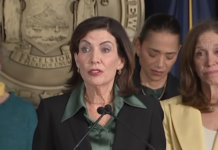In a recent incident that stirred up a bit of controversy, a man dressed as the Grinch made an unexpected appearance outside Sleepy Hollow Elementary School in Amarillo, Texas. Holding a sign that read, “Santa is fake, Jesus is real,” his presence during the morning drop-off upset some parents. What ensued was a clash of beliefs and values that caught the attention of the local community.
A man dressed as The Grinch stood outside of a Texas elementary school holding a sign that read:
“Santa is fake, Jesus is real” pic.twitter.com/m8yWtN7JvL
— Daily Loud (@DailyLoud) December 4, 2023
The Incident Unfolds
The man behind the Grinch costume, identified as David Grisham, stood on the sidewalk outside the school, making a bold statement challenging the existence of Santa Claus. The intention behind his action was to emphasize the significance of the birth of Jesus Christ, rather than focus on the “magic” associated with Christmas.
One father, visibly displeased with Grisham’s message, decided to take matters into his own hands. He grabbed the sign and threw it on the ground, leading to a physical altercation between the two. The entire incident was captured on video and quickly spread across social media platforms.
Police Intervention and Legalities
Upon receiving reports of the altercation, local authorities were called to the scene. However, to the surprise of many, Grisham was not arrested. The police stated that he was “lawfully on the sidewalk” and did not violate any laws with his actions. This decision further fueled the ongoing debate surrounding freedom of expression and the boundaries of acceptable behavior.
Perspectives on the Controversy
The incident left parents divided, with some understanding Grisham’s intention to emphasize the religious aspect of Christmas. On the other hand, many argued that he should not have imposed his beliefs on other people’s children. Sleepy Hollow Principal Kelsey Williams expressed her disappointment with Grisham’s uninvited presence, highlighting the fear it instilled in some students and their families.
Grisham’s Justification
When questioned about why he chose to disrupt the “magic” of Christmas, Grisham remained steadfast in his beliefs. He explained that his focus was not on the concept of magic but rather on the miraculous virgin birth of Jesus Christ. Grisham attributed the negative reactions to pride and a reluctance to acknowledge the falsehood of perpetuating the Santa Claus narrative.
A Familiar Face in Amarillo
Grisham’s actions were not entirely surprising to local law enforcement, as he has been a self-proclaimed street preacher for several years. Police stated that they occasionally receive calls about him from concerned citizens. This incident, however, brought his message and methods into the spotlight, generating both support and condemnation from the community.
Impact on Children and Families
The controversy sparked a broader conversation about the impact of conflicting beliefs on young children. Some parents expressed concern that the incident shattered the innocence and joy associated with Christmas for their kids. They argued that children should be allowed to embrace the magic of the season without interference from external influences.
Freedom of Expression vs. Respect for Others
The clash between Grisham and the offended father raised questions about the balance between freedom of expression and the need to respect the beliefs and feelings of others. While Grisham had the right to express his religious convictions, some argued that there are appropriate contexts and places for such discussions, and the school environment was not one of them.
Lessons Learned and Moving Forward
Sleepy Hollow Elementary School used this incident as an opportunity to reinforce their commitment to fostering a safe and inclusive environment for all students. Principal Williams assured parents that steps would be taken to prevent similar disruptions in the future. The controversy served as a reminder of the importance of open dialogue and respectful discussions when it comes to matters of belief and religion.



![Watch: Brandon Gill Forces the Truth About White Christian Nationalism [Video]](https://pagetraveler.com/wp-content/uploads/2025/12/brandon-gill-218x150.png)